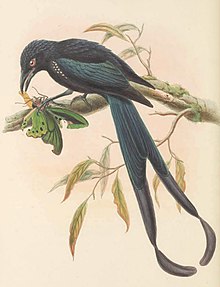The paradise drongo or ribbon-tailed drongo (Dicrurus megarhynchus) is a species of bird in the family Dicruridae. It is endemic to New Ireland in the Bismarck Archipelago, Papua New Guinea. With a total length of 51 to 63 cm (20 to 25 in) and body mass of 130 g (4.6 oz), this may be the largest species of drongo.[2][3]
| Paradise drongo | |
|---|---|

| |
| Illustration by John Gould and W. Hart | |
| Scientific classification | |
| Domain: | Eukaryota |
| Kingdom: | Animalia |
| Phylum: | Chordata |
| Class: | Aves |
| Order: | Passeriformes |
| Family: | Dicruridae |
| Genus: | Dicrurus |
| Species: | D. megarhynchus
|
| Binomial name | |
| Dicrurus megarhynchus | |
Taxonomy edit
The paradise drongo was described by the French zoologists Jean Quoy and Joseph Gaimard in 1832 from a specimen that they believed had been collected in Dorey (now Manokwari) in New Guinea. They coined the binomial name, Edolius megarhynchus.[4][a] The English zoologist Philip Sclater pointed out in 1877 that the location reported by Quoy and Gaimard was probably an error. Specimens had been collected from New Ireland in the Bismarck Archipelago but none had been obtained from New Guinea.[6] The type locality is now designated as Port Praslin near the southern point of New Ireland.[7]
Notes edit
References edit
- ^ BirdLife International (2016). "Dicrurus megarhynchus". IUCN Red List of Threatened Species. 2016: e.T22706999A94102176. doi:10.2305/IUCN.UK.2016-3.RLTS.T22706999A94102176.en. Retrieved 17 November 2021.
- ^ Rocamora, G. and D. Yeatman-Berthelot (2020). Ribbon-tailed Drongo (Dicrurus megarhynchus), version 1.0. In Birds of the World (J. del Hoyo, A. Elliott, J. Sargatal, D. A. Christie, and E. de Juana, Editors). Cornell Lab of Ornithology, Ithaca, NY, USA.
- ^ Dunning, John B. Jr., ed. (2008). CRC Handbook of Avian Body Masses (2nd ed.). CRC Press. ISBN 978-1-4200-6444-5.
- ^ Quoy, Jean; Gaimard, Joseph Paul (1830). Dumont d'Urville, Jules (ed.). Voyage de la corvette l'Astrolabe : exécuté par ordre du roi, pendant les années 1826-1827-1828-1829: Zoologie (in French). Vol. 1. Paris: J. Tastu. pp. 184–185.
- ^ Mlíkovský, Jiří (2012). "The dating of the ornithological part of Quoy and Gaimard's "Voyage de l'Astrolabe"". Zoological Bibliography. 2 (2&3): 59–69.
- ^ Sclater, Philip (1877). "On the birds collected by Mr. George Brown, C.M.Z.S., on Duke-of-York Island, and on the adjoining parts of New Ireland and New Britain". Proceedings of the Zoological Society of London. 1877:Jan.-Apr.: 96–114 [101].
- ^ Mayr, Ernst; Greenway, James C. Jr, eds. (1962). Check-list of birds of the world. Vol. 15. Cambridge, Massachusetts: Museum of Comparative Zoology. p. 153.
External links edit
